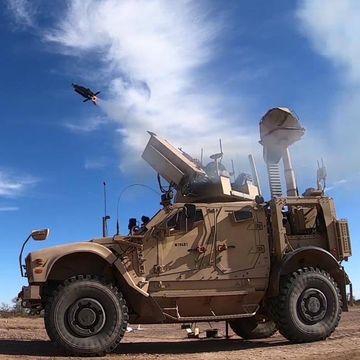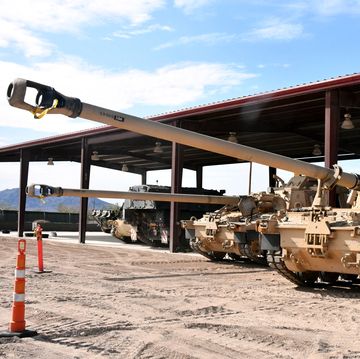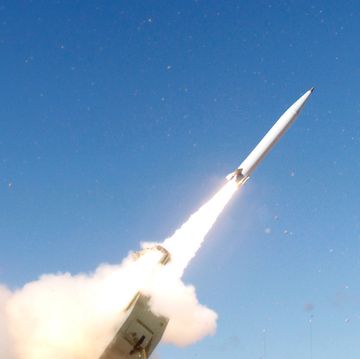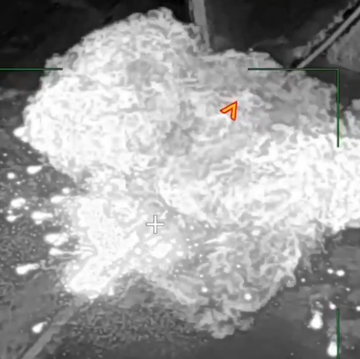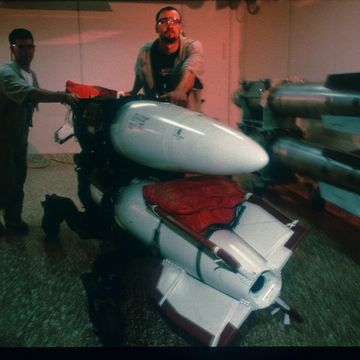Russia's next-generation main battle tank can fire an anti-tank missile at targets more than seven miles away. That gives the T-14 Armata tank, set to begin testing with the Russian Army in 2019, nearly twice the range of the America's latest version of the venerable Abrams, the M1A2 SEP V3. Whether this extended range is all the useful is another matter.
The T-14 is a formidable-looking beast. Armed with a new 125-millimeter main gun, an unmanned turret, modular armor, and an active protection system designed to shoot down incoming missiles, the vehicle has caused a stir within NATO's tank community. One particularly dangerous feature is the Armata's ability to destroy targets at ranges of up to 12 kilometers, or 7.4 miles.
For years, Russia has armed its tanks with laser-guided missiles that can be fired from the main gun. The first generation missile, the 9M112 Kobra , was installed on the Cold War-era T-80 tank. Kobra had a range of 4 kilometers, or 2.5 miles, and could penetrate up to 700 millimeters of armor. The current missile, the 9M119 Reflecks, has a range of 3.1 miles and can penetrate up to 900 millimeters of armor. Here's the Reflecks in action:
Armata will initially be armed with an improved version of the Reflecks, the 9M119M1. But a new missile called the 3UBK21 Sprinter is planned, and it's the one with the 7-plus-mile range. Armor penetration is unknown but will likely be at least the equivalent of Reflecks.
By contrast the American M1 Abrams' M256 120-millimeter smoothbore gun has a maximum effective range between 3 km (1.86 miles) and 4 km (2.48 miles). In military parlance, the Armata could very well "out-stick" the M1 by a factor of three, comfortably destroying American tanks before the latter can get within engagement range.
In real-world war situations, though, there are rarely situations where two objects at ground level are visible to one another at seven and a half miles. Hedges, trees, buildings, elevation changes, and other terrain features all conspire to block visibility at ground level. Outside of the plains of Kansas, the Russian steppes, and the Sinai desert, there are seldom places where two objects are visible at even three or four miles.
Even if an Armata does manage to lock onto an Abrams at extreme ranges, the American tank isn't helpless. The Abrams' armor, reinforced with a layer of depleted uranium and now reactive armor, is widely considered the best in the world. Reactive armor is particularly useful against the shaped charge warhead on the Sprinter. Also, the Army is planning to install active protection systems (APS) on the Abrams. An APS upgrade would consist of outward-facing radar antennas scanning for incoming threats in all directions. One detected, APS launches interceptors to and detect and kill incoming rockets and missiles.
One potential scenario that could take full advantage of Sprinter's range is as an anti-air weapon. Sprinter is believed to have an air defense capability as the Russians, and many client states that may wish to buy the Armata are afraid of Western attack helicopters such as the AH-64E Apache Guardian. Fixed-wing aircraft, including drones, are also likely targets. Although Sprinter was conceived as an anti-tank weapon, it might in fact be more useful as an anti-air weapon.
Via Defence-Blog

Kyle Mizokami is a writer on defense and security issues and has been at Popular Mechanics since 2015. If it involves explosions or projectiles, he's generally in favor of it. Kyle’s articles have appeared at The Daily Beast, U.S. Naval Institute News, The Diplomat, Foreign Policy, Combat Aircraft Monthly, VICE News, and others. He lives in San Francisco.








